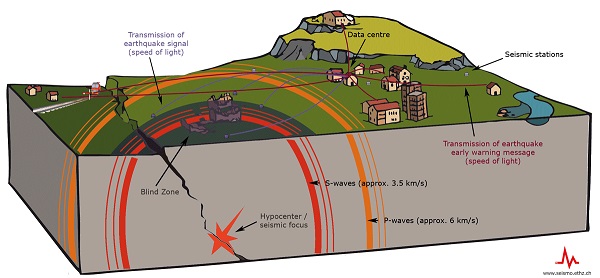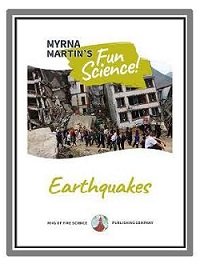what is an Earthquake?
Why does the Earth shake, rattle, and roll?
Causes of earthquakes
Some of the causes of earthquakes are rocks fracturing, volcanoes erupting, and man made explosions. We feel earthquakes when seismic waves inside the Earth travel through the Earth to where we are after an earthquake.

Swiss early warning system for residents
Earthquake's Focus and seismic waves
Focus of an earthquake
The point where the rocks rupture is the focus of an earthquake. The geographic location on the surface of the Earth directly above the focus is the epicenter of an earthquake.
P waves
All earthquakes produce P waves and S waves that travel through the Earth. P waves are compression waves and arrive first at reporting stations. The waves cause the rocks to compress and expand like movement through a slinky as the waves travel through the Earth.
S waves
S waves are secondary waves because they arrive at reporting stations after the P waves. S waves only travel through the solid Earth and stop when they reach the outer core of the Earth which is liquid.


Click for More Information and to Order
Most earthquakes occur at Plate boundaries
Plate boundary earthquakes
Ninety percent of the earthquakes on Earth are produced at plate boundaries. A convergent boundary is a place where two plates are coming together creating a subduction zone. Great earthquakes that produce tsunamis occur when rocks fracture in these subduction zones.
Transform boundary earthquakes
A transform boundary like the San Andreas Fault produces thousands of earthquakes each year. The mid ocean ridge forms where two plates are separating. The boundary produces small earthquakes as molten rock moves from the mantle to the surface of the ocean floor.
earthquake scales used by scientists
Two major earthquake scales
There are two major scales that describe the size of earthquakes. The Richter scale is used generally for reporting earthquakes. It was designed in 1934 and when news reports describe an earthquake as a 6.2 magnitude quake they are using the Richter scale.
Moment magnitude scale
Great earthquakes that occur along subduction zones use the moment magnitude scale because it includes the size of the earthquake as well as the size of the seismic waves. The largest earthquake ever recorded was the 1960 Chile earthquake that registered 9.5 on the moment magnitude scale.
KIDS FUN Science Bookstore
Check out Myrna Martin's award winning textbooks, e-books, videos and rock sets. The Kids Fun Science Bookstore covers a wide range of earth science topics. Click here to browse.










